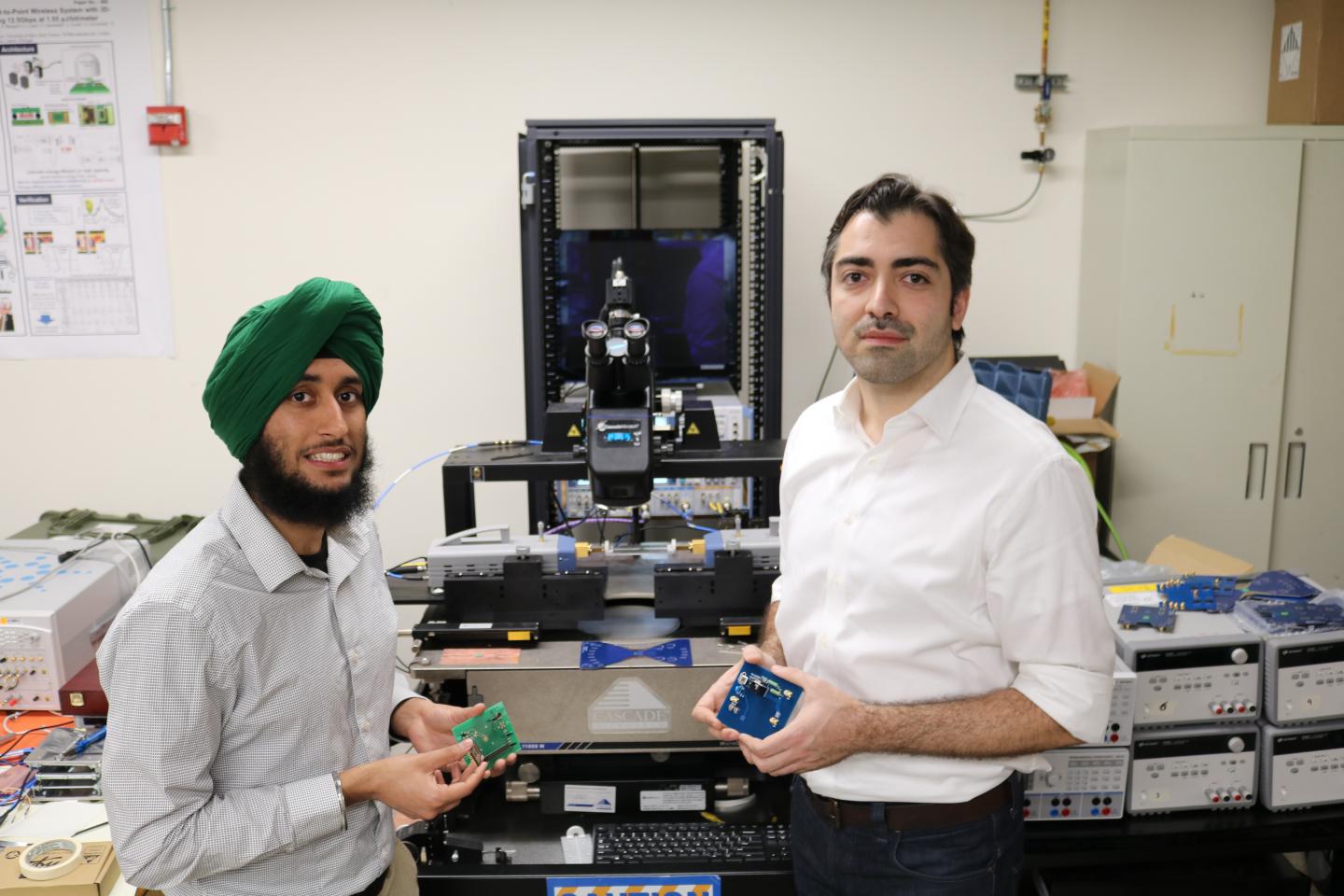
This is Amin Arbabian, assistant professor of electrical engineering (right), and graduate student Angad Rekhi (left) with their ultrasonic wake-up receiver and the circuit boards used to test its performance. Credit: Arbabian Lab/Stanford University
As smartphone users know all too well, a sleeping device can still suck the life out of a battery. One solution for extending the battery life of wireless devices under development by researchers at Stanford University is to add a wake-up receiver that can turn on a shut-off device at a moment’s notice.
Angad Rekhi, a graduate student in the Arbabian lab at Stanford, and Amin Arbabian, assistant professor of electrical engineering, have developed a wake-up receiver that turns on a device in response to incoming ultrasonic signals – signals outside the range that humans can hear. By working at a significantly smaller wavelength and switching from radio waves to ultrasound, this receiver is much smaller than similar wake-up receivers that respond to radio signals, while operating at extremely low power and with extended range. The group is presenting the work at the International Solid-State Circuits Conference on Feb. 14.
This wake-up receiver has many potential applications, particularly in designing the next generation of networked devices, including so-called “smart” devices that can communicate directly with one another without human intervention.
“As technology advances, people use it for applications that you could never have thought of. The internet and the cellphone are two great examples of that,” said Rekhi. “I’m excited to see how people will use wake-up receivers to enable the next generation of the Internet of Things.”
The power tradeoff
Once attached to a device, a wake-up receiver listens for a unique ultrasonic pattern that tells it when to turn the device on. It needs only a very small amount of power to maintain this constant listening, so it still saves energy overall while extending the battery life of the larger device. A well-designed wake-up receiver also allows the device to be turned on from a significant distance.
Arbabian said the designing these electronic devices posed a number of challenges. “Scaling down wake-up receivers in size and power consumption while maintaining or extending range is a fundamental challenge,” he said. “But this challenge is worth pursuing, because solving this problem can enable scalable networks of wake-up receivers working in our everyday environment.”
In order to miniaturize the wake-up receiver and drive down the amount of power it consumes, the researchers made use of the highly sensitive ultrasonic transducers provided by the Khuri-Yakub lab at Stanford, which convert analog sound input to electrical signals. With that technology, the researchers designed a system that can detect a wake-up signature with as little as 1 nanowatt of signal power, about 1 billionth the power it takes to light a single old-fashioned Christmas bulb.
Given the increased interest in networked devices, researchers and industry organizations are starting to define what features and techniques will become standard. Regardless of whether this ultrasound wake-up receiver is among these standard designs, it is likely wake-up receivers of some kind will be integrated into commercial applications soon, Rekhi said.
Connecting the future
This work branched off from a previous Arbabian lab creation, a tiny chip dubbed the “ant-sized radio” that can send and receive signals over radio waves without a battery. The ant-sized radio has the advantage of being wirelessly powered but needs to remain relatively close to the transmitter with which it communicates. The group has since published a way of using ultrasound to extend the powering range of devices like the ant-sized radio, but that distance is still limiting.
By comparison, the ultrasound wake-up receiver requires a battery but has much greater range than the wirelessly powered devices, while still maintaining a long lifetime due to extremely low power draw. These two technologies – wireless power and wake-up receivers – would likely serve different purposes but both hint at a turning point in devices that make up the internet of things.
In light of a long-promised future where interconnected, autonomous, widespread, unobtrusive technologies make lives easier, the networked devices available now, like video doorbells and app-enabled lights, seem like rather subtle advances, the researchers said. They believe technologies like theirs could help span the gap between the internet of things as we know it and the internet of things at its best – whatever that may be.




